Podcast
Questions and Answers
What do producers do in a food chain?
What do producers do in a food chain?
- Provide shelter for consumers
- Consume other organisms
- Convert solar energy into chemical energy (correct)
- Decompose organic matter
All organisms in a food web are either producers or consumers.
All organisms in a food web are either producers or consumers.
True (A)
What is the main role of primary consumers in an ecosystem?
What is the main role of primary consumers in an ecosystem?
Herbivores that eat plants.
The process where carbon is released back into the atmosphere is called ______.
The process where carbon is released back into the atmosphere is called ______.
Match the following cycles to their key processes:
Match the following cycles to their key processes:
Which of the following is not a type of consumer?
Which of the following is not a type of consumer?
Biodiversity is insignificant for ecosystem resilience.
Biodiversity is insignificant for ecosystem resilience.
What is a mechanical mixture?
What is a mechanical mixture?
What type of change results in the production of new substances?
What type of change results in the production of new substances?
Metalloids possess properties of both metals and non-metals.
Metalloids possess properties of both metals and non-metals.
What is the formula to calculate density?
What is the formula to calculate density?
The process of charging an object by rubbing it against another is called ______.
The process of charging an object by rubbing it against another is called ______.
Match the following celestial objects with their descriptions:
Match the following celestial objects with their descriptions:
Which of the following statements about electric charges is true?
Which of the following statements about electric charges is true?
Earth's revolution refers to its spin on its axis.
Earth's revolution refers to its spin on its axis.
What is produced when hydrogen peroxide decomposes?
What is produced when hydrogen peroxide decomposes?
Flashcards
Food Chain
Food Chain
A linear sequence showing energy transfer from producers to consumers.
Food Web
Food Web
A complex network of interconnected food chains in an ecosystem.
Producers
Producers
Organisms that make their own food through photosynthesis.
Consumers
Consumers
Signup and view all the flashcards
Sustainability
Sustainability
Signup and view all the flashcards
Tolerance Range
Tolerance Range
Signup and view all the flashcards
Limiting Factor
Limiting Factor
Signup and view all the flashcards
Solution
Solution
Signup and view all the flashcards
Chemical Change
Chemical Change
Signup and view all the flashcards
Physical Change
Physical Change
Signup and view all the flashcards
Density
Density
Signup and view all the flashcards
Specific Heat Capacity
Specific Heat Capacity
Signup and view all the flashcards
Families (Periodic Table)
Families (Periodic Table)
Signup and view all the flashcards
Atomic Number
Atomic Number
Signup and view all the flashcards
Mass Number
Mass Number
Signup and view all the flashcards
Bohr-Rutherford Diagram
Bohr-Rutherford Diagram
Signup and view all the flashcards
Study Notes
Biology
- Food Chains: Linear sequences showing energy transfer. Example: Grass → Grasshopper → Frog → Snake → Hawk
- Food Webs: Complex interconnected networks of food chains in an ecosystem.
- Trophic Levels:
- Producers (Autotrophs): Convert solar energy to chemical energy (plants).
- Primary Consumers: Herbivores (rabbits).
- Secondary Consumers: Carnivores/omnivores eating herbivores (foxes).
- Tertiary Consumers: Top predators (eagles).
- Producers: Organisms making their own food (plants, algae).
- Consumers:
- Herbivores: Eat only plants (deer).
- Carnivores: Eat only animals (lions).
- Omnivores: Eat both plants and animals (humans).
- Sustainability: Maintaining ecological processes over time. Key concepts: biodiversity resilience, avoid resource over-exploitation, balance environment, economics, and social factors.
- Nitrogen Cycle: Nitrogen fixation, nitrification, denitrification, decomposition. Key terms: ammonia, nitrate, nitrogen gas.
- Water Cycle: Evaporation, condensation, precipitation, runoff, infiltration, transpiration.
- Carbon Cycle: Photosynthesis, respiration, combustion, decomposition move carbon through atmosphere, biosphere, oceans, and lithosphere.
- Photosynthesis: 6CO₂ + 6H₂O → C₆H₁₂O₆ + 6O₂.
- Cellular Respiration: C₆H₁₂O₆ + 6O₂ → 6CO₂ + 6H₂O + Energy. Photosynthesis stores energy, respiration releases it.
- Tolerance Range: Range of abiotic factors where an organism survives.
- Optimal Range: Conditions where organisms thrive.
- Limiting Factors: Abiotic/biotic factors restricting population growth (temperature, water).
Chemistry
- Matter and Mixtures:
- Solution: Homogeneous mixture (saltwater).
- Compound: Two+ elements chemically combined (H₂O).
- Element: Pure substance of one atom type (oxygen).
- Mechanical Mixture: Heterogeneous mixture (salad).
- Physical Properties: Characteristics observed without changing identity (density, color, boiling point).
- Chemical Properties: Describe reactivity (flammability, reactivity with acid).
- Physical Change: Changes state or appearance (melting ice).
- Chemical Change: Produces new substances (rusting).
- Density: Density = Mass ÷ Volume.
- Unusual Water Behavior: High specific heat capacity, expands when frozen (less dense as a solid).
- Metals, Non-Metals, Metalloids:
- Metals: Shiny, conductive, malleable (iron).
- Non-Metals: Dull, brittle, poor conductors (sulfur).
- Metalloids: Properties of both (silicon).
- Periodic Table:
- Families: Alkali metals, alkaline earth metals, halogens, noble gases.
- Trends: Atomic size decreases across a period; reactivity varies (metals more reactive down a group).
- Atomic Number: Number of protons.
- Mass Number: Protons + Neutrons.
- Bohr-Rutherford Diagrams: Showing protons, neutrons, and electron arrangement around nucleus.
- Molecular vs. Ionic Compounds:
- Molecular: Nonmetals sharing electrons (H₂O).
- Ionic: Metals transferring electrons to nonmetals (NaCl).
- Hydrogen Peroxide: Decomposes into water and oxygen; store in cool, dark conditions.
Physics
- Law of Electric Charges: Like charges repel, opposite attract.
- Static vs. Current Electricity:
- Static: Buildup of charges.
- Current: Flow of electrons in a circuit.
- Charging Methods:
- Friction: Rubbing transferring electrons.
- Conduction: Direct contact transferring charge.
- Induction: Nearby charged object inducing charge.
- Grounding: Removing excess charge by connecting to Earth.
- Circuits: Components (resistor, switch, battery, bulb).
- Series Circuits: One path, shared voltage.
- Parallel Circuits: Multiple paths, equal voltage.
- Efficiency: (Useful energy output ÷ Total energy input) × 100%.
- Electrical Power: P = IV (Power = Current × Voltage).
- Cost of Energy: Energy (kWh) = Power (kW) × Time (h).
Space
- Celestial Objects:
- Meteoroid: Small rock in space.
- Meteor: Burns in Earth's atmosphere.
- Meteorite: Reaches Earth's surface.
- Asteroid: Rock orbiting the Sun.
- Comet: Ice and dust, tail forms near the Sun.
- Planets:
- Gas Giants: Jupiter, Saturn, Uranus, Neptune.
- Terrestrial: Mercury, Venus, Earth, Mars.
- Earth's Motion:
- Rotation: Earth spins (day/night).
- Revolution: Earth orbits Sun (year).
- Satellites:
- Natural: Moon.
- Artificial: Communication, weather, GPS.
- Other Concepts:
- Redshift: Light stretches as objects move away.
- Polaris: North Star; aligns with Earth's axis.
- Eclipses:
- Solar Eclipse: Moon blocks Sun.
- Lunar Eclipse: Earth blocks sunlight from Moon.
Studying That Suits You
Use AI to generate personalized quizzes and flashcards to suit your learning preferences.




